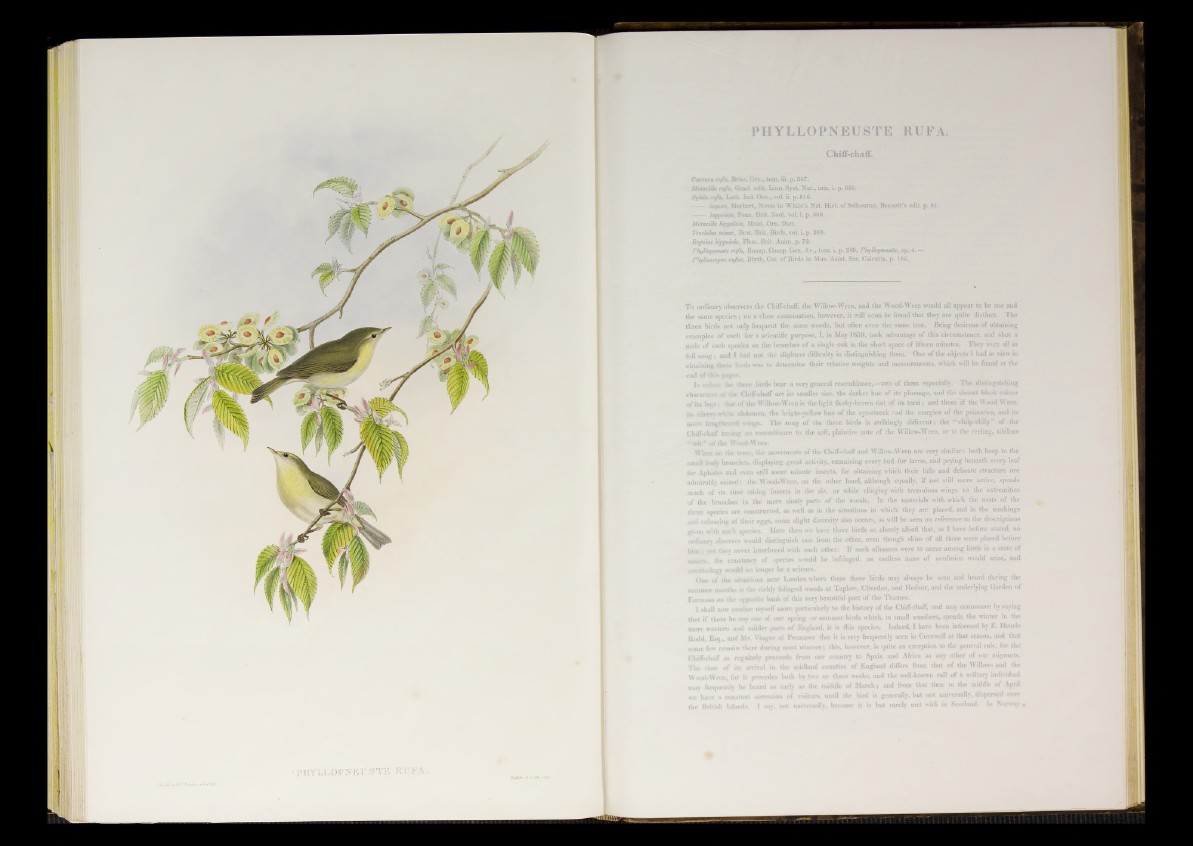
Chiff-chaff.
Curruea rtifa, Briss. Orn., tom. ill. p. 387.
MotaciUa ntfa, Gmel. edit. Linn. Syst. Nat., tom. i. p. 955.
Sylvia rtfa, Lath. Ind. Orn., vol. u. p. 516.
loqnax. Herbert, Notes to White's Nat. Hist, of Selbourne, Bennett’s edit. p. 81.
hippoLua, Penn. Brit. Zool. vol. i. p. 508.
MotaciUa hippolais, Mont. Orn. Diet.
TrochUut minor, Bcw. Brit. Birds, vol. i. p. 268.
Reguhu hippolais, Flem. Brit. Anim. p. 72.
Phyllopneuste ntfa, Bonap. Consp. Gen. Ay., tom. i. p. 289, Phyllopneuste, sp. 4.—•
Phylloscopu* r t f vs, Blyth, Cat. of Birds in Mus. Asiat. Soc. Calcutta, p. 185.
To ordinary observers the Chiff-chaff, the Willow-Wren, and the Wood-Wren would all appear to be one and
the same species ; on a close examination, however, it will soon be found that they are quite distinct. The
three birds not only frequent the same woods, but often even the same tree. Being desirous of obtaining
examples of each for a scientific purpose, I, in May 1859, took advantage of this circumstance, and shot a
male of each species on the branches of a single oak in the short space of fifteen minutes. They were all in
foil song ; and I had not the slightest difficulty in distinguishing them. One of the objects I had in view in
obtaining these birds was to determine their relative weights and measurements, which will be found at the
end o f Has paper.
In colow the three birds bear a very general resemblance,—two o f them especially. The distinguishing
c h a ra c te r o f the Chiff-chaff are its smaller size, the darker hue o f its plumage, and the almost black colour
of its let's - that o f the Willow-Wren is the light fleshy-brown tint of its tarsi ; and those of the Wood Wren,
its silverv-white abdomen, the bright-yellow hue of the eye-streak rnd the margins of the primaries, and its
more lengthened wings. The song of the three birds is strikingly different ; the “ cbilp-chilp ” of-the
Chiff-chaff having no resemblance to the soft, plaintive note o f the Willow-Wren, or to the reeling, sibilous
“ trit ” of the Wood-Wren.
When on the trees, the movements of the Chiff-chaff and Willow-Wren are very similar : both keep to the
»mail leafV branches, displaying great activity, examining every bud for larvae, and prying beneath every leaf
for Aphides and even still more minute insects, for obtaining which their bills and delicate structure are
admirably suited: the Wood-Wren, on the other hand, although equally, if not still more active, spends
much o f its time taking insects in the air, or while clinging with tremulous wings to the extremities
o f the branches in the more shady parts of the woods. In the materials with which the nests of the
three species are constructed, as well as in the situations in which they are placed, and in the markings
and colouring of their eggs, some slight diversity also occurs, as will be seen on reference to the descriptions
given with each species. Here then we have three birds so closely allied that, as I have before stated, no
ordinary observer would distinguish one from the other, even though skins of all three were placed before
him ; vet they never interbreed with each other. If such alliances were to occur among birds in a state of
nntwrr the constancy of species would be infringed, an endless mass of confusion would arise, and
ornithology would no longer be a science.
One of the situations near London where these three birds may always be seen and heard during the
summer months is the richly foliaged woods at Taplow, Cliveden, and Hedsor, and the underlying Garden of
Formosa on the opposite bank of this very beautiful part of the Thames.
I shall now confine myself more particularly to the history of the Chiff-chaff, and may commence by saying
that if there be any one of our spring or summer birds which, in small numbers, spends the winter in the
more western and milder parts of England, it is this species. Indeed, I have been informed by E . Hearle
Rodd, Esq., and Mr. Vingoe of Penzance that it is very frequently seen in Cornwall at that season, and that
some few remain there during most winters; this, however, is quite an exception to the general rule, for the
Chiff-chaff as regularly proceeds from our country to Spain and Africa as any other of our migrants.
The time of its arrival in the midland counties of England differs from that of the Willow- and the
Wood-Wren, for it precedes both by two or three weeks, and the weU-knowu call of a solitary individual
may frequently be heard as early as the middle of March ; and from that time to the middle of April
we have a constant accession of visitors, until the bird is generally, but not universally, dispersed over
the British Islands. I say, not universally, because it is but rarely met with in Scotland. In Norway